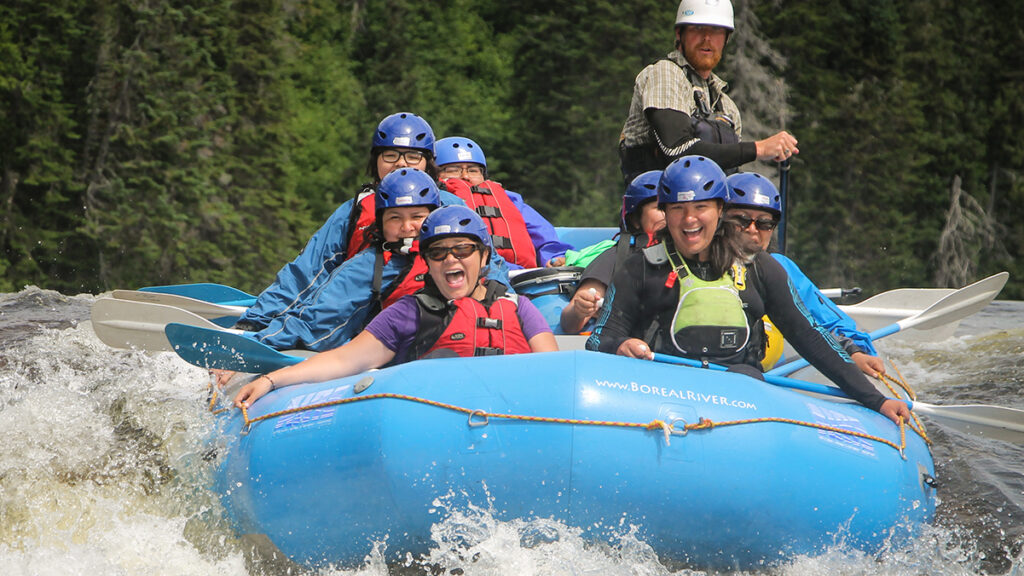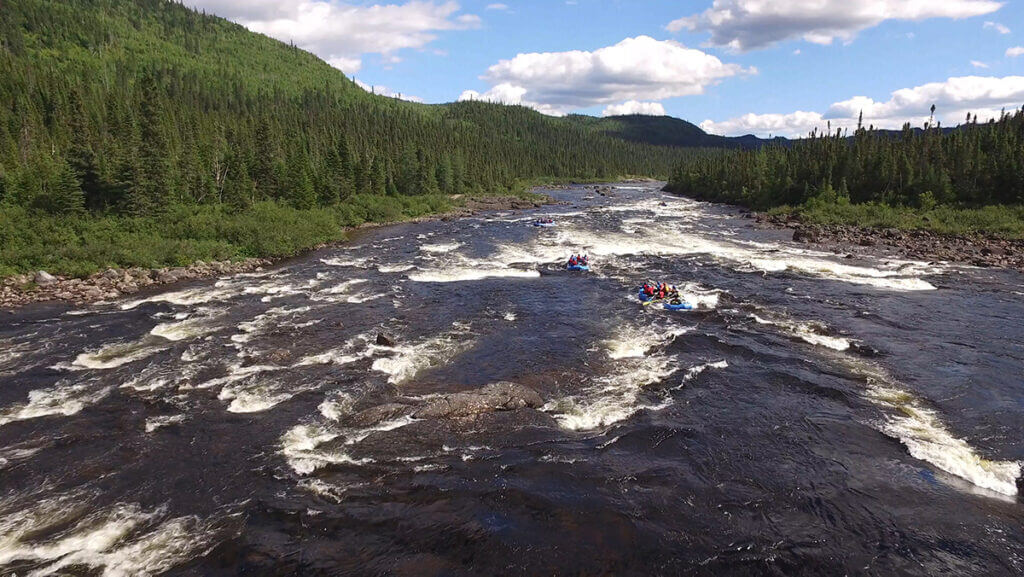What’s my raft guide thinking at the top of a rapid?
Trip leader Ty Smith explains what’s on his mind when river guiding
By Willa Mason, Guide and Instructor
For those considering a rafting adventure, whitewater may seem chaotic and unpredictable.
Though it’s normal to be nervous, professional guides are trained to analyze the situation and to make good decisions based on the safety and the goals of your group. There’s a lot to think about on a rafting trip, but your guide will take care of most of it, so you don’t have to.

On a typical multi-day rafting trip, 2-3 experienced guides facilitate an overnight trip for 6-10 participants. Trips range from 2-14 days. The group begins each morning (after coffee, of course!) by packing up their campsite, loading the gear into three rafts, and then travelling downstream to reach another campsite by day’s end. Guides provide technical expertise, historical, geological and cultural tidbits, delicious camp meals, and notoriously bad jokes. The duration of the trip, difficulty of whitewater, and stunning scenery differ from river to river.
Each guide is different, but there are some key factors that occupy your guide’s brain throughout the trip. This is how Ty thinks about it: the environment, route, and safety will dictate whether his rafting crew can run a rapid, and the skill level, health, and participant preference influence whether Ty chooses to run the rapid.
Factors Outside the Raft
Know the environment
Guides are constantly evaluating the weather, wind direction, and water temperature. Their eyes are trained to notice clouds gathering overhead, and their ears are trained to hear whitewater around the bend. They’re experts at adapting. The chosen route down a rapid is called a “line”. A warm, sunny day is great for playing in rapids and taking splashy lines, whereas a windy, chilly day may call for more conservative lines.
Pick the route
Once the environmental conditions have been assessed, it’s time to think about what’s on the whitewater menu for the day. If a rapid is shorter and easier, the guide can spot the line from their seat in the raft. Longer rapids may require the guide to walk along shore to get a better view of the rapid. It’s the guide’s responsibility to select a route down the rapid that avoids obstacles such as rocks or big waves.

To help keep things simple, Ty likes to break the rapid into chunks, identifying and assessing each maneuver as an individual component. He picks out a landmark in each section to identify where the raft needs to be. Then, he assesses whether each landmark can be connected to the next, creating a sequential route that will safely get the raft from top to bottom of the rapid. He wants to set the raft up for success. If one landmark can’t be smoothly connected to the next, this interrupts the sequence and means it’s time to start looking for alternate options.
Explore alternatives
Many rapids have more that one possible line. There might be a big wavy route that doesn’t require much maneuvering, as well as a calmer line that may require technical navigation between tightly placed rocks. Most rapids also provide the option for rafters to skip the rapid by walking around it. Even if Ty used a specific route down a particular rapid on his last trip, he still considers all the options, and picks the one most suitable for that day and that crew.
How can it be safer?
Once Ty’s picked his preferred line down the rapid, he takes a moment to consider how he can make the rapid safer for all involved.
In most scenarios, a guide who’s familiar with the rapid will go first, to be a helpful landmark for the next rafts to follow. Some trips will have a kayaker to accompany the raft down the rapid for extra back up. He also notes that it’s very important to tell paddlers what will happen if the line doesn’t go as planned. While it doesn’t happen often, falling out of the raft could mean a fun splashy float in some rapids, or it could be hazardous in others. Ty adjusts his route and safety plan based on these potential consequences.
Also read: 3 Common Myths About Rafting Trips
Factors inside the raft
Skill level
While there are normally four to six paddlers in a raft, each rafter plays an important part in the success of the descent. Experienced rafters understand how the raft moves through current, proactively paddling to properly position the raft. Less experienced paddlers may need more guidance and a longer reaction time.
Comfort Level
Ty also finds it very important to decipher what each individual paddler feels keen for. Some might love the idea of being ejected from the raft, hooting and hollering as they swim through the remaining waves, while others may seek a near-guarantee of dry hair. Ty tries to ensure that each paddler is comfortable with every possible outcome. He also assigns seats in the raft based on individual comfort levels. In guiding, no action is haphazard or coincidence, and Ty’s intentional rearranging of the raft is a true testament of such!

Health
Your river guide is also thinking about each person’s health. It’s important to adjust their decisions based on fitness levels, physical limitations, or other chronic conditions that could impact a rafting trip. While rafting can be for everyone, it’s a guide’s role to make it as doable as possible. It’s their job to realize when someone needs a break or a helping hand to hoist up a backpack.
Guest preference
Ty talks to each participant about their goals, so that he can try to meet them. This way, he can help the whole group to succeed, based on their definition of success. His baseline for decision making in guiding is this: achieving success based on what that means for each person.
Conclusion
To illustrate the essence of being an adventure tourism professional, Ty uses the example of a mountain guide. They are there to help participants accomplish their summit goal, but may need to turn the group around mere metres from the top if necessary.

Similarly, river guides are there to help you accomplish as many of your goals as possible, while their ultimate priority is to keep the team safe.
While your guide considers the environmental factors, as well as individual skill levels, health, and preferences, you’re free to think about the scenery, the whitewater, the wilderness, the food, the waves, the history, the geography…
Also read: 6 Best Multi-Day Rafting Trips In Canada.
More about Ty Smith
Expert river guide, Ty Smith, aims “to run challenging rapids to gain competency, and through competency, gain confidence.” This mentality has allowed him to log hundreds of hours running rapids recreationally, as well as practice making tough decisions in dynamic outdoor environments. Translating this experience into professional work on the river was a natural progression; Ty has guided overnight raft trips on the Magpie River, and day trips in Quebec, Ontario, British Columbia, Costa Rica, and Chile. He’s paddled every style of river in nearly every type of watercraft. With an extensive education background in environmental science, focused on examining contaminants in waterways, Ty’s almost always out on the river. If not, he’s definitely thinking about it.

